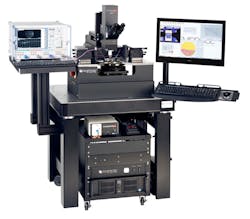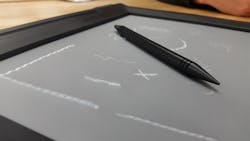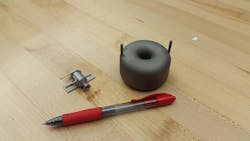Now that we are well-lubed from our brewery tour in Part 4, it’s back to work. Many areas understand that one path to an innovative, diverse, and strong economy is by generating new companies. Vermont is no stranger to the startup life, and in this part of our tour, we’ll be traveling to the Vermont Center for Emerging Technologies, commonly called VCET. David Bradbury, VCET’s president, and Phoebe Lo, operations coordinator, introduced a few startups based at VCET—Semiprobe, EASY Tactile Graphics, and Benchmark Space Systems.
“We charge about $100 a month,” said Bradbury. “That basically covers the cost of how much coffee we go through.” Furthermore, VCET looks for early-stage, high-opportunity, technology-based companies in Vermont. High opportunity sometimes follows high risk. With only enough money to cover the cost of coffee, how does the VCET not implode?
Through careful research on animals and humans, VCET’s president mentioned if more than 100 people, bees, or monkeys occupy a single space, it affects productivity. Adopting that philosophy, as well as planning in increments of 36 months at a time, represents some of the ways this center is able to operate smoothly and effectively.
The Vermont Seed Capital Fund is a revolving, “evergreen” equity fund with $5 million of initial capitalization from the state of Vermont and U.S. Senator Patrick J. Leahy. The Vermont Economic Development Authority (VEDA) is a strategic partner for this fund. Since 1974, VEDA has provided over $2.49 billion in financing assistance to thousands of eligible Vermont entrepreneurs, manufacturers, small businesses, and agricultural enterprises, helping them to realize their business growth goals, create jobs, and enhance the vitality of Vermont’s economy. Working in partnership with Vermont banks to help meet the financing needs of Vermont businesses, VEDA’s low-interest programs help Vermont’s economy grow and prosper.
By offering companies and entrepreneurs access to early-stage risk capital ranging from $25,000 to $250,000, the fund can act as lead investor or as part of an investment syndicate. “We proudly support our companies from start to finish,” said Bradbury. “They’re teams of talented entrepreneurs that through active coaching, education, co-working spaces, and investment find value in VCET. Needs and wants from our members and companies vary greatly from just our business advice or a space to work to deeper engagement via a direct investment. So far, we’ve backed 21 startups and emerging growth firms with this venture fund.”
Doug Merrill, CEO of Semiprobe, says founders Denis Place, Mostafa Daoudi, and Don Feuerstein formed SemiProbe in 2006 to address market voids in the analytical probing market. Collectively, before founding SemiProbe, they worked as managers at SUSS MicroTec North American Probing Division in Waterbury Center, Vermont for 35 years. They founded SemiProbe with several objectives in mind:
- Capital equipment is expensive: Get more for your money! SemiProbe platforms reduce lifetime costs for our customers. Our systems evolve with our customer’s needs, dramatically extending their useful lifespan.
- Provide the most modular and flexible probing platform: We give our customers the capability to adapt, customize, and upgrade systems to their specific needs.
- Perpetual field upgrade path: SemiProbe’s systems and patented technology give customers the ability to upgrade their existing systems with new modules and accessories. All key building blocks of the Probe System for Life (PS4L) are interchangeable and upgradeable.
The Probe System for Life, or PS4L, is one of Semiprobe’s products. It’s able to rapidly configure the probe station to meet specific application requirements, optimize all test elements for the highest performance, transform the system at your site when requirements or the environment changes, and more.
The next speaker was Josh Coffee, President of Engineering to Assist and Support You LLC, otherwise known as EASY Tactile Graphics. Sponsored by the National Foundation for the Blind, Josh has developed inTact. It is essentially a sheet of polymer that deforms as users write on it with a stylus. There is even an eraser that uses heat to iron smooth the raised lines formed by the stylus.
This is just a tool being used by EASY Tactile Graphic. As the world moves to digital online learning, blind students may find it increasing difficult to keep up. This is why the company is also working on finding the most proficient way to communicate with the blind and visually impaired by generating a tactile curriculum for younger students.
However, it isn’t just learning—simply having the ability to draw raised lines can change how someone is able to get around. Tasha Chemel is a blind artist and writer. She is currently pursuing her Master’s degree at Harvard Graduate School of Education, where she will study adolescent literacy and creative writing. She also hopes to develop innovative opportunities for blind people to participate in visual culture.
On the EASY Tactile Graphics website, Chemel shared her experience when a friend gave her a tactile map to get around campus. “For the first time in my life, I was able to form a comprehensive map of an area that spanned about 18 blocks. This was a huge accomplishment for me. I had been told early in life that I was a route traveler (a person who can only utilize set routes), as opposed to an area traveler (a person who can orient and problem-solve without having learned a specific route). Shlomiya’s map empowered me to see past these limiting assumptions.
The polymer sheets can be “erased” about three times before they start to degrade. This helps reduce the cost, since these sheets are still expensive compared to paper.
“My story illustrates why a product like the inTACT Sketchpad is so invaluable for blind students and the people who work with them. If all of my mobility teachers had had access to the sketchpad, they would have been able to produce tactile maps cheaply and efficiently. All students need opportunities to get to know themselves as learners, and part of this process is exposure to a wide range of instructional tools. Blind students are no exception. That is why I am so supportive of EASY’s mission to increase graphical fluency in children who are blind.” Read the whole story here.
Out of this World
VCET diversity is evident, from helping blind visual learners to advancing CubeSats in low orbit space. Benchmark Space Systems CEO Ryan McDevitt talked about how his innovative propulsion systems can extend the time a CubeSat is in space. A CubeSat is a small, generally a 10-in. cube, satellite that can fill the voids on the spaceship to lower the cost of the new commercial space programs. While popular, they can still be expensive, costing hundreds of thousand dollars.
These parts, 3D-printed out of metal, are changing the way we observe space.
Some problems with CubeSats are that they can bump into each other or tumble once released into space. This can limit the types of experiments that can be performed. For instance, experiments that need to track a celestial body might yield inaccurate results if tumbling were to occur. And adding propulsion systems to a CubeSat increases the cost.
However, Benchmark Space Systems found a low-cost solution to help CubeSat propulsion. In fact, McDevitt mentioned one of the chemicals used to create thrust was actually being used in Subway sandwiches to help the bread rise faster. While he didn’t say what the chemical was, azodicarbonamide is sometimes used as a blowing agent in expanding foams. Azodicarbonamide might create thrust by expanding chemicals—for example, let’s say, foam—through a nozzle.
In Subway’s defense, the chemical was FDA approved; the company removed it from the bread in 2014. According to Bloomberg, “McDonald’s, Chick-fil-A, Wendy’s, White Castle, and Jack in the Box, which all used the chemical in their breads in 2014, have since gotten rid of it entirely.”
Low-cost propulsion does two main things. One, it extends the length of the mission. Because CubeSats are in low orbit, they are subject to drag. This resistance causes the CubeSat to enter the Earth’s atmosphere and burn up, effectively ending the experiment and disintegrating the CubeSat. Two, it can make sure any remains of the CubeSat doesn’t land in someone’s backyard. Generally, this isn’t a concern, as anything left of a CubeSat upon reentry are tiny specks too small to cause any damage to anything. As previously mentioned, it would also allow for better tracking and orientation in space, potentially extending the types of experiments that could be performed by a lower-cost CubeSat.
After the presentation, I left VCET with a new found respect for the impact Vermont is having not just on the U.S., but the world and low-orbit space. Next, in Part 6, I head to Dynapower Corp. to check out energy-storage systems, inverters, rectifiers, and custom transformers. Finally, we stop by Logic Supply to talk about its innovative management strategy, and the technology behind a 15-foot-tall, 12,000-lb. fighting robot from MegaBots. Yes if you read to the end, there will be giant fighting robots.





